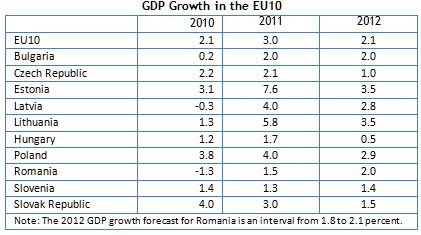These achievements are impressive, as they have come in spite of the challenging external environment. Growth of the global economy is now losing momentum and the expansion of the EU15 is expected to slow down further in 2012. Since the EU10 is closely tied through production, trade, and finance with the EU15, growth in the EU10 is also projected to weaken, but is set to remain higher than in the EU15.

With the 2008/09 crisis, economic performance diverged across the region, as countries with larger macroeconomic imbalances underwent sharper contractions. In 2012, the difference in the growth performance across the EU10 is set to diminish. Growth in Estonia, Lithuania, and Latvia, the leaders in growth in 2011, is expected to decline in line with weakening export markets. Hungary is projected to grow slower than other countries in the region as domestic demand remains weak and exports are slowing down. Only Slovenia and especially Romania are set to increase growth from 2011 to 2012 thanks to stronger domestic demand. Only in Poland, Slovakia, and the Czech Republic, 2012 output is projected to exceed pre-crisis levels.
“Growth in the EU10 is set to decline from 3.0 percent in 2011 to 2.1 percent in 2012. And even though Poland’s growth is also expected to decline from 4.0 percent in 2011 to 2.9 percent in 2012, Poland is still growing faster than most EU countries thanks to strong domestic demand and competitive businesses,” said Kaspar Richter, Senior Economist in the World Bank’s Europe and Central Asia Region and lead author of the report. “Poland will have reduced the gap to EU15 living standards by almost 10 percentage points within just 4 years. This outstanding performance is set to continue in 2012,” added Richter.
The EU10 prospects remain uncertain. With around two-thirds of EU10’s exports going to the EU, and around four-fifths of EU10’s banking assets in foreign ownership, renewed European and global tensions could spread to the EU10.
“A weak and uncertain economic outlook means that securing the recovery through strong, three-pronged policy action is essential,” said Peter Harrold, World Bank Country Director for Central Europe and the Baltic Countries. “The EU10’s policy challenges entail shoring up confidence in financial markets, sticking with fiscal consolidation plans, and addressing the core structural issues to improve competiveness,” added Harrold.
To be more specific, the report recommends that governments, central banks, and financial supervisory authorities across the EU have to shore up confidence of financial markets. Building on recent policy measures, priorities include prudent risk assessments, following-up plans for recapitalization and restructuring of banks as needed, and bolstering the resilience and stability of the financial system through macro-prudential regulations.
Second, while monetary policy can be supportive of the recovery in light of low inflation pressures, most EU10 countries have to pursue fiscal consolidation in line with their plans. This would ensure that weak fiscal balances do not become a source for financial market volatility.
Finally, the report emphasizes that structural policies in support of growth can help to overcome the financial, labor, and fiscal challenges. This means making workers and businesses more productive through EU funds and FDI flows, improving technology, and strengthening skills. Deepening economic and financial ties between the EU10 and the EU15 is part of this agenda. The strong record of convergence over the last two decades demonstrates the benefits of closer integration in spite of today’s economic problems.





